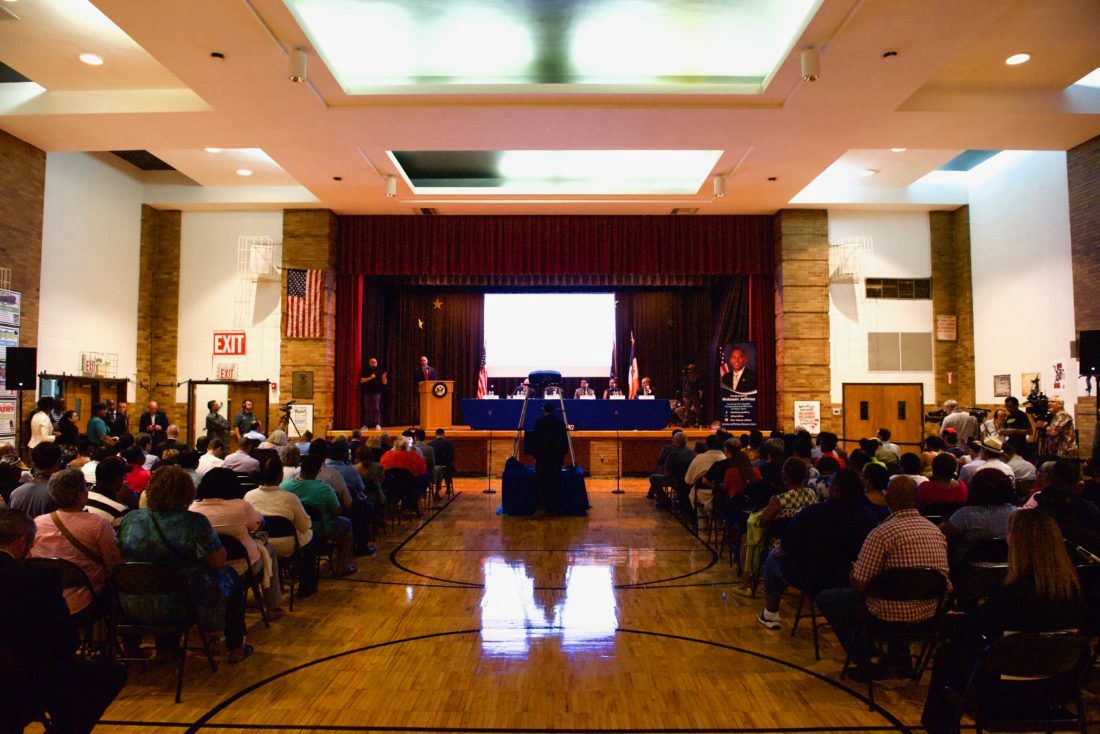L train will continue to run from Rockaway Parkway to Bedford Avenue in Brooklyn – Canarsie L Train Town Hall


CANARSIE – The MTA’s traveling town hall tour finally reached Canarsie last night, giving attendees representing neighborhoods south of Broadway Junction a chance to learn more about the “L Train Shutdown” and pose questions to a panel of representatives.
Hosted by Congressman Hakeem Jeffries (D-8), the event took place at Canarsie Ascend Charter School, just around the corner from the Rockaway Parkway station and the end of the L line.
An obvious issue was messaging: many in attendance were unclear on whether or not the entirety of the L Train would be shut down for the 15-month project, which starts in April 2019. While the MTA has been pushing hard to frame the work as the “Canarsie Tunnel Reconstruction,” most of the media (BKLYNER included) has used the colloquial “L Train Shutdown” to refer to the project—which isn’t entirely accurate.
“I hope they keep it between here and Broadway Junction,” said Cathy Joseph, a Canarsie resident of 18 years, who commutes on the L train from 105 Street and switches to the LIRR a few stops later at Atlantic Avenue.
After a brief presentation from NYCTA President Andy Byford, which has been shown at previous town halls across Brooklyn and Manhattan, Byford made sure to directly address the extent of the project, assuring the roughly 250 people in attendance that the L train would continue to run from Rockaway Parkway to Bedford Avenue in Brooklyn—a clarification that brought a round of applause from the audience.
According to the MTA, 81% of L train riders between Canarsie and Broadway Junction only use the train within Brooklyn, and hopefully, won’t be particularly impacted by the project.
Still, there are those from Canarsie who make their long commutes all the way into Manhattan, and will need to find another way across the East River.
George Bettman, who commutes from Rockaway Parkway to work at 14th Street/Union Square, and wraps up his job around 11:30 pm, was concerned about late-night J train service, which he feels isn’t often enough. When he asked about increasing the frequency of trains, the roundabout answer—basically, that the JMZ can’t run more trains—left him unsatisfied.
Others who spoke have already switched to the 3 train, but found its service to be too slow, too often plagued by weekend closures and stoppages—which, to be fair, can be said about much of the MTA.
The night’s biggest round of applause was reserved for the suggestion of a free transfer between the L train and the LIRR, which would allow passengers to jump on the unaffected Manhattan-bound lines at Atlantic-Barclays. Officials on the panel said they would revisit the idea before the shutdown starts, assuring the audience that they were still open to suggestion.
More than once, when general complaints about the MTA surfaced, Byford used the event to pivot to his Fast Forward Plan to modernize the MTA, a 10-year jump ahead that would install new communication systems and increase power stations across the system, allowing the MTA to run more trains, more often, with fewer breakdowns.
Byford is currently on what he called “a shameless roadshow” for political support, which is desperately needed to secure funding for the plan, which is estimated at $30 billion.
After one customer complained about rudeness from MTA employees when assisting customers that have accessibility issues, Byford surprised the crowd by announcing that all 50,000 employees of NYCTA would be undergoing sensitivity training in order to better assist all customers. Accessibility across the system has been a major part of Byford’s plans for the MTA.
Between the Town Hall meetings and public engagement ahead of the Canarsie Tunnel Repairs, it’s clear the MTA is looking ahead to address both immediate and future concerns about the system. But even with all the planning, Brooklynites are as skeptical as ever, and many will be holding their breath come April 2019.




